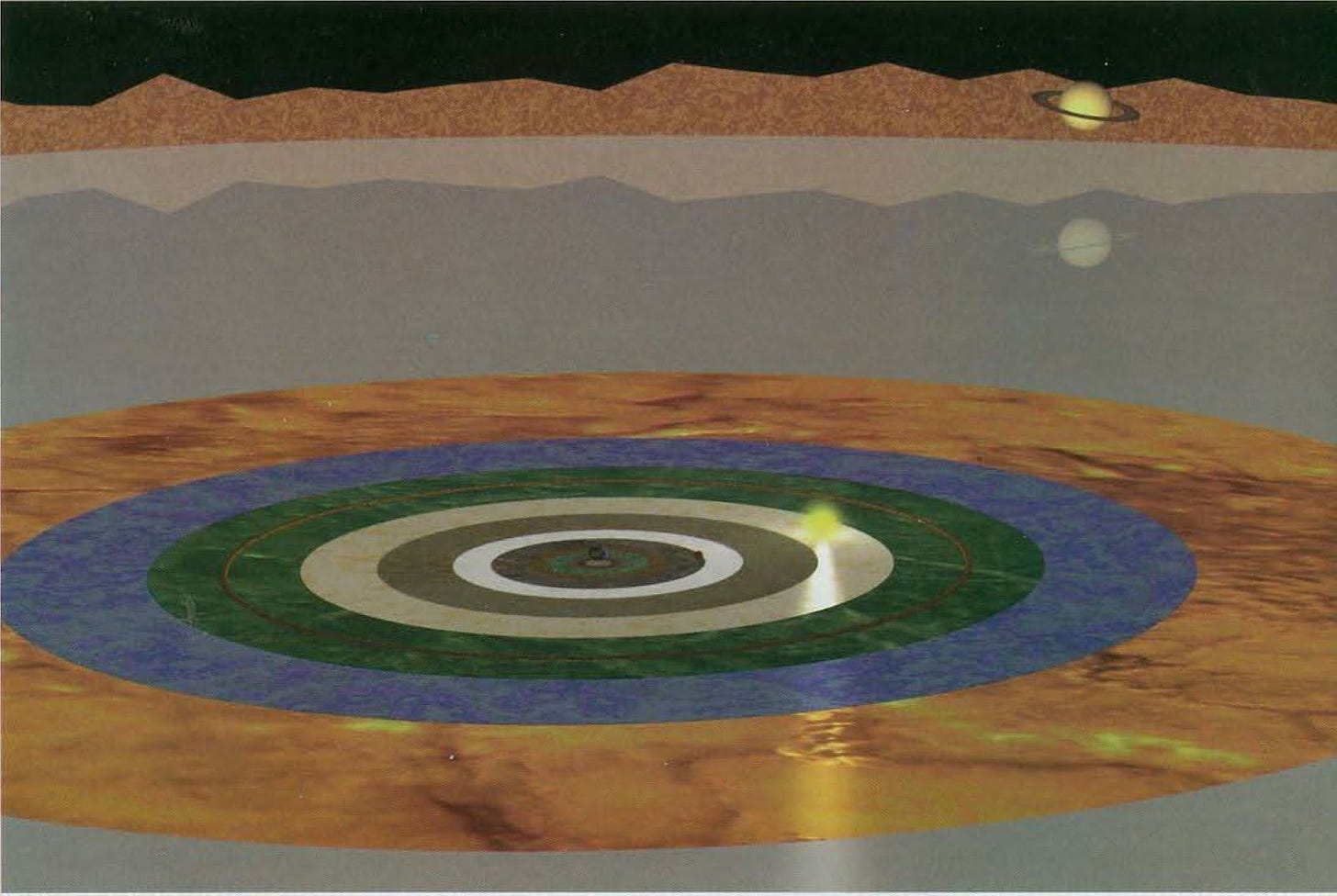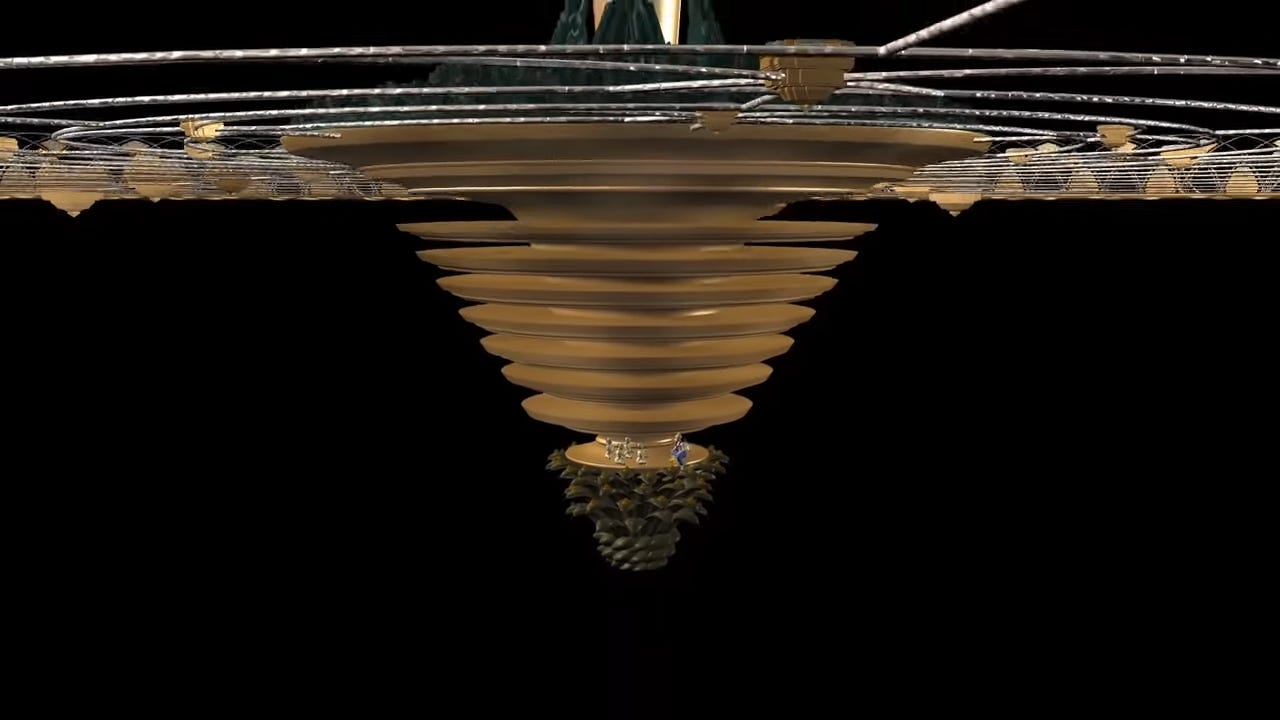The vertical dimension (The Intriguing Vedic Universe, ch.1.2)
Jambudvipa is surrounded by a series of concentric islands. Beyond it, there is a huge concentric mountain called Lokaloka, which marks the boundary of the illuminate portion of the universe.
'The Intriguing Vedic Universe' was my first book on Vedic cosmology, explaining the mysterious universe described in the Srimad Bhagavatam. It describes not just the physical aspects, in a level of detail that rivals modern science, but also the metaphysical aspects, the missing aspect that is missing in the modern perspective.
The other islands
Jambudvipa and its salt ocean are surrounded by a series of concentric islands called Plaksadvipa, Salmalidvipa, Kusadvipa, Krauncadvipa, Sakadvipa, and Puskaradvipa. Each of these islands has its own ocean, and each is two times wider than the previous. In this way, the distances increase exponentially, culminating with the 51,200,000 miles of Puskaradvipa.
Beyond it, there is a huge concentric mountain called Lokaloka, which marks the boundary of the portion of the universe that is illuminated by the sun. After the Lokaloka mountain, there is Aloka-varsa, a dark tract of land where the rays of the sun are not visible.
On the top of Lokaloka Mountain, there are four huge elephants (called Gaja-patis) that balance it, preventing it from tilting in any direction.
The total distance from Mount Sumeru to the Lokaloka mountain is 125,000,000 yojanas (1 billion miles), and Aloka-Varsa extends for the same distance. The universe thus has a radius of 250,000,000 yojanas (from Mount Sumeru to Lokaloka Mountain), and the total diameter of the universe is calculated as 500,000,000 yojanas or 4 billion miles.
Bhu-Mandala is thus a gigantic flat structure that is fixed in place. According to Vedic cosmology, the sun goes around Mount Sumeru in a circular orbit. It’s described that the sun-god seats in a chariot that has only one wheel. One side of the axle is fixed at the top of Mount Sumeru, and the side with the wheel goes on Manasottara Mountain, situated in the middle of Puskaradvipa.
Vertically, the sun is situated close to the plane of Bhu-Mandala, and horizontally it is situated close to Sumeru Mountain. It circles around Bhu-Mandala once a year, and as a result, the inhabitants of Bhu-Mandala receive less sunlight during part of the year. When the sun is in the north, the inhabitants of the south receive less light and when the sun is in the south the inhabitants of the north receive less light. This led to the pastime of King Priyavrata creating an artificial sun and circling Bhu-Mandala on the opposite side to make the distribution of light equal (SB 5.1.30).
This diagram made by Sadaputa Prabhu gives the idea of the orbit of the sun around Bhu-Mandala:
Advanced Astronomy, Back to Godhead
This may at first appear like a very simplistic description that doesn’t explain the movements of the sun as we observe on our planet, including the passage of the days and nights and the seasons of the year. It happens that the orbit of the sun in the Vedic model is much more complex than it may appear at first glance. We will discuss this in more detail in the following chapters.
Apart from the orbit of the sun, Srimad Bhagavatam also describes the orbits of the planets of our solar system. All the planets circle around in orbits higher than the plane of Bhu-Mandala. Different from Bhu-Mandala, which is a flat structure, all the planets are globes that float in space, much like believed in modern astronomy. According to the description, however, the moon is much bigger and more distant, being 800,000 miles above the sun over the plane of Bhu-Mandala.
Considering that the axis of the sun is supported by Mount Sumeru (which has an elevation of 84,000 yojanas, or 672,000 miles, above the plane of Bhu-Mandala), we can calculate that the moon described in the Srimad Bhagavatam is much more distant than the gross moon studied in modern astronomy. We will discuss more on this point in the subsequent chapters.
The vertical dimension
Apart from this horizontal description of the universe, which describes Jambudipa and the other islands that form Bhu-Mandala, there is also a vertical description of the universe, which describes the other planetary systems. These planetary systems are described as being like discs positioned one on top of the other.
Very close to our plane, starting from the area of the upper atmosphere there is the plane of Bhuvarloka, inhabited by the subtle beings who are followers of Kuvera. Their realm spreads around Mount Sumeru. It's described in the Mahabharata that the Pandavas visited this realm while traveling through the Himalayas, being able to access mount Sumeru through paths that are inaccessible to us.
Higher than Bhuvarloka is Swargaloka, the abode of the demigods. Swargaloka is situated higher than the top of Sumeru mountain. Demons frequently go there to battle the demigods, and sometimes they win, temporarily gaining control over the celestial plane.
10,000,000 yojanas higher than Swargaloka is Maharloka, and 20,000,000 higher than Maharloka is Janaloka. These are the abodes of great sages who dedicate their lives to worshiping Lord Vishnu and cultivating spiritual knowledge. These are higher elevated beings, who live for extraordinarily long lifespans and are unaffected by the disputes between the demons and demigods.
Diagram of the different planetary systems from the Rupanuga Vedic College
80,000,000 yojanas above Janaloka is Tapoloka, the abode of great ascetics, who perform solitary meditation on the Supersoul. This is the planet where the Four Kumaras live. 120,000,000 yojanas above Tapoloka is Brahmaloka, the abode of Lord Brahma and the most elevated planetary system of our universe. Only extraordinarily elevated souls can take birth there.
You can find a detailed description of life in these different planetary systems in the Brhad Bhagavatamrta, a book that describes the travelings of Gopa Kumara through the higher planetary systems and his experience in these different planes. Although it may sound like a work of fiction at first, the Brihad Bhagavatamrta narrates a true story that happened long ago in a different universe, a story that Sanatana Goswami could capture in his meditation and write in the pages of his book.
Just like there are planetary systems above our plane, there are also the lower planetary systems. These are subterraneous realms that are situated lower than the plane of Bhu-Mandala. These are the abodes of the Asuras, consisting of the planes of Atala, Vitala, Sutala, Talatala, Mahatala, Rasatala and Patala. Lower than Patala are the hellish planets, the abode of Yamaraja, and still lower is Ananta-Sesa, who sustains the whole Universe on the top of His hoods.
Illustration of the seven subterraneous planetary systems from the ToVP
At first, this description may seem very bizarre, since it's completely different from what we can see using our senses, or any type of instrument we have at our disposal. It's very easy to attest that the earth is not flat (one just needs to take a plane and go around it), and it's easy to see that we don't have a gigantic island with a golden inverted cone 672,000 miles high after the north pole.
Srila Prabhupada was quick to point out that since this explanation is given in the Srimad Bhagavatam, it must be correct. The sastras are not the fruit of mundane experimentation, but a knowledge that is received from higher sources, going all the way to Krsna himself. Since Krsna is perfect, the knowledge of the Vedas must also be perfect, and this includes not only the metaphysical knowledge about the soul but also the cosmological model of the Universe given in the Srimad Bhagavatam. If the description given in the Puranas sounds too far out it's just because there is a deficiency in our perception or the methods we are using to try to understand it.
However, Srila Prabhupada didn't try to explain all the details of this model himself. Instead, he left the mission to explain it and depict it in the Vedic Planetarium to his disciples and grand disciples. As he wrote in a letter to Svarupa Damodara (27 April, 1976): “So now you all Ph.D.'s must carefully study the details of the 5th Canto and make a working model of the universe. If we can explain the passing seasons, eclipses, phases of the moon, passing of day and night, etc. then it will be very powerful propaganda.”
At the time they looked for Indian astronomers and astrologers who could explain it, but they were as perplexed by it as the devotees themselves. They even brought a pandit to see Srila Prabhupada, but he quickly had to admit that he could not explain it.
The first to try to explain it in a scientific way was Sadaputa Prabhu, followed by Drutakarma Prabhu and others. By studying their works, I started to understand that the cryptic description of the Universe in the Srimad Bhagavatam is quite fascinating and holds the key to a higher level of understanding. There is a lot more information there than it appears on the surface.





